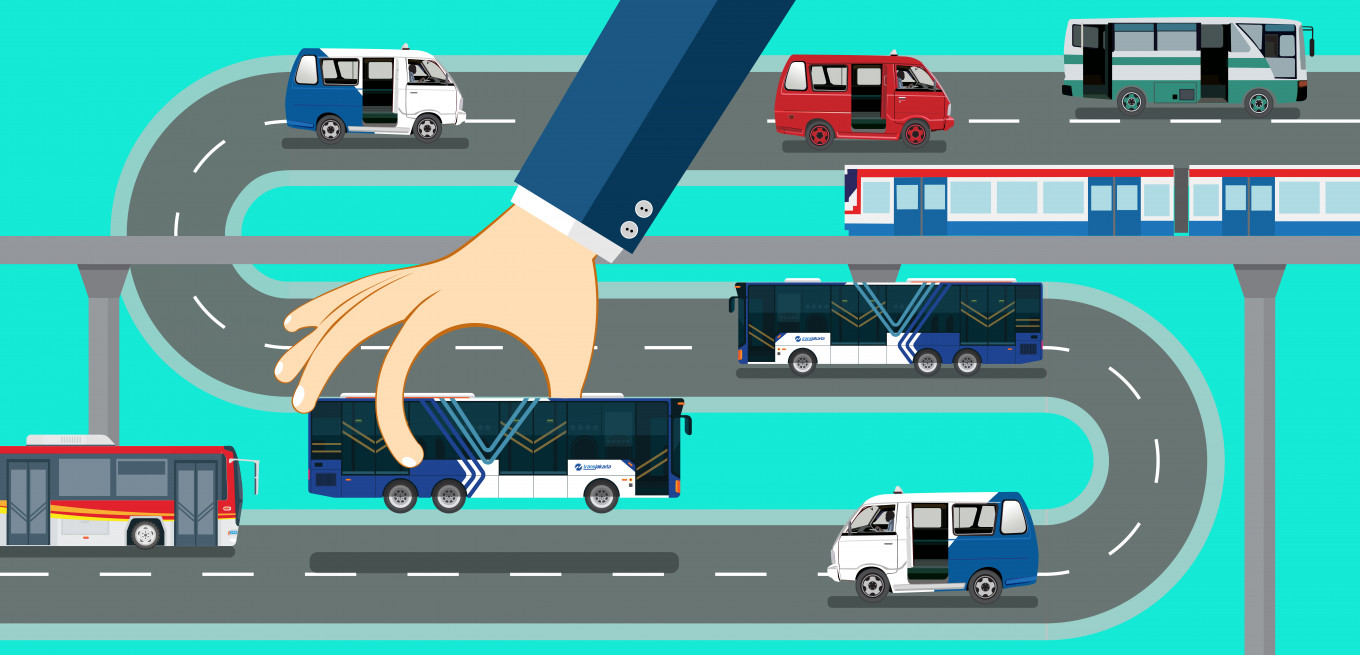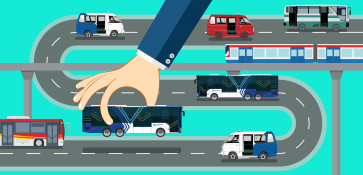Popular Reads
Top Results
Can't find what you're looking for?
View all search resultsPopular Reads
Top Results
Can't find what you're looking for?
View all search results
- -
- Fri, October 20, 2023
Change text size
Gift Premium Articles
to Anyone
Work It Right is a weekly column that provides practical and insightful advice on the complexities of urban transportation.
Recently, President Joko “Jokowi” Widodo appointed Coordinating Minister for Maritime Affairs and Investment Luhut Pandjaitan, whose job is currently being handled by State-Owned Enterprises (SOEs) Minister Erick Tohir, to integrate public transportation systems in Jakarta and Bogor, Depok and Bekasi in West Java (Jabodebek).
What does this mean for commuters living outside Jakarta?
To give you an idea of the inequality of public transportation services in Jabodetabek, the Lebak Bulus area in South Jakarta is a perfect example.
The area has an MRT station, a Transjakarta station and stop-and-go station for Mikrotrans (Transjakarta minibuses), an inter-city inter-provincial (AKAP) bus terminal and a stop for angkot (public minivans) from South Tangerang, Banten.
Even with all these modes, the connectivity between them is insufficient, for example, the connectivity between the MRT and the South Tangerang angkot. People connecting from the MRT station have no other option but to jaywalk to reach those angkot, which, in rush hour is dangerous as the vehicle traffic is very high.
The South Tangerang angkot cannot approach the curb-side bus stop adjacent to the MRT station as this space is exclusively dedicated to Transjakarta services. As South Tangerang’s angkot service is separate from the Transjakarta service, this poor connectivity has avoidable consequences.
Besides the poor connectivity, the inequality is also shown in the conditions of the various fleets, including the availability of information related to each service. Ticket prices and fare structure are among the basic information about which passengers should be well informed.
Through its public transportation operators, such as Transjakarta, Jakarta already has a better sense of mitigating the problem by physically providing information on stations and its digital media publications. However, information for semi-formal public transportation, like the angkot and regular buses, is usually hard to find.
This is not a surprise since the high-quality mass public transportation, including the bus rapid transit (BRT) system development, is still concentrated in Jakarta and barely reaches neighboring cities/regencies.
Under the central government, the Commuter Line rail service is the only mass transit mode covering all the administrative areas within Greater Jakarta. This is due to the fact that most of the mass public transportation modes operated in Jakarta were built by the city’s regional-owned companies. In contrast, neighboring cities/regencies lack the financial capacity to build mass transit systems within their regions. This difference in institutions and authority is why the service level of each public transportation mode, particularly those administered by different regions, is unbalanced.
The government has attempted to address the uneven development of mass public transportation in Jabodetabek by establishing the Greater Jakarta Transport Authority (BPTJ) through Presidential Regulation No. 103/2015, under the Transportation Ministry. However, the challenges of integrating public transportation planning and operation across the Greater Jakarta area still need to be addressed. Compliance with the minimum service standards (SPM) set by each public transportation policymaker still needs to improve, despite the penalty of license cancellation for public transportation operators who violate these agreements being in place.
Moreover, apart from the limitation of inter-regional public transportation development, the current system faces many challenges in applying integrated inter-modal public transportation measures, including fare integration. This, in turn, affects the discussion on subsidies provided or on an interim well-developed integrated fare scheme under the ownership of the Jakarta administration.
Public transportation for all
A joint study between ITDP Indonesia and United Kingdom-based Partnering for Accelerated Climate Transitions (PACT) explains the opportunity for a joint company between SOEs and region-owned enterprises (BUMD) to optimize the management of public transportation integration. This recommendation aligns with data on the number of multi-trip card users who travel on the Commuter Line, the MRT and LRT, amounting to 905,485 per day last September. In addition, the Jakarta administration is improving public transportation management to integrate with other modes of transportation from the first mile through the Mikrotrans service. Such is the case with the BPTJ's pilot project in Bogor city through BisKita to provide inter-modal integration accessibility to Bogor Commuter Line Station.
Are all these efforts enough to integrate the system?
Institutional integration in public transportation might be the answer, but before we jump into it, there are two main aspects to remember: regulators and integrated public transportation managers. One of the recommendation options for integrated regulators includes the establishment of a new ministry-level institution that has authority over all public transportation services in Jabodetabek, including the ability to provide cross-regional subsidies. The BPTJ can accommodate that to some extent, so the next step is to strengthen the authority of the BPTJ.
Meanwhile, one of the recommendations for integrated public transportation managers is implementing a business entity involving the central and regional governments to provide public transportation services regardless of administrative borders within Jabodetabek.
With the future expansion of public transportation networks, such as the construction of MRT and LRT across provinces, where Jakarta-funded MRT infrastructure will enter other administrative areas (concerning maintenance and ownership status of the infrastructure), the issue of public transportation integration becomes an urgent matter to be implemented.
-- Have a question about urban transportation? Send it to wir@thejakartapost.com with your name and current location (anonymous submissions will also be considered). Please note that The Jakarta Post reserves the right to edit your letters for publication.
***
The writer is a senior communications and partnership manager at the Institute for Transportation and Development Policy (ITDP)
Have a question about urban transportation? Send it to wir@thejakartapost.com with your name and current location (anonymous submissions will also be considered). Please note that The Jakarta Post reserves the right to edit your letters for publication.









